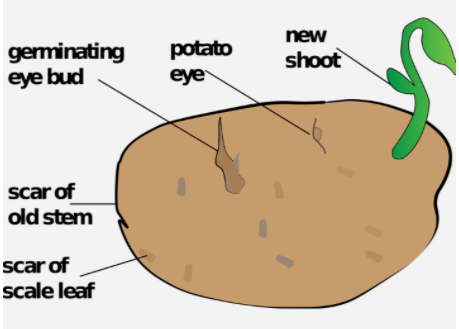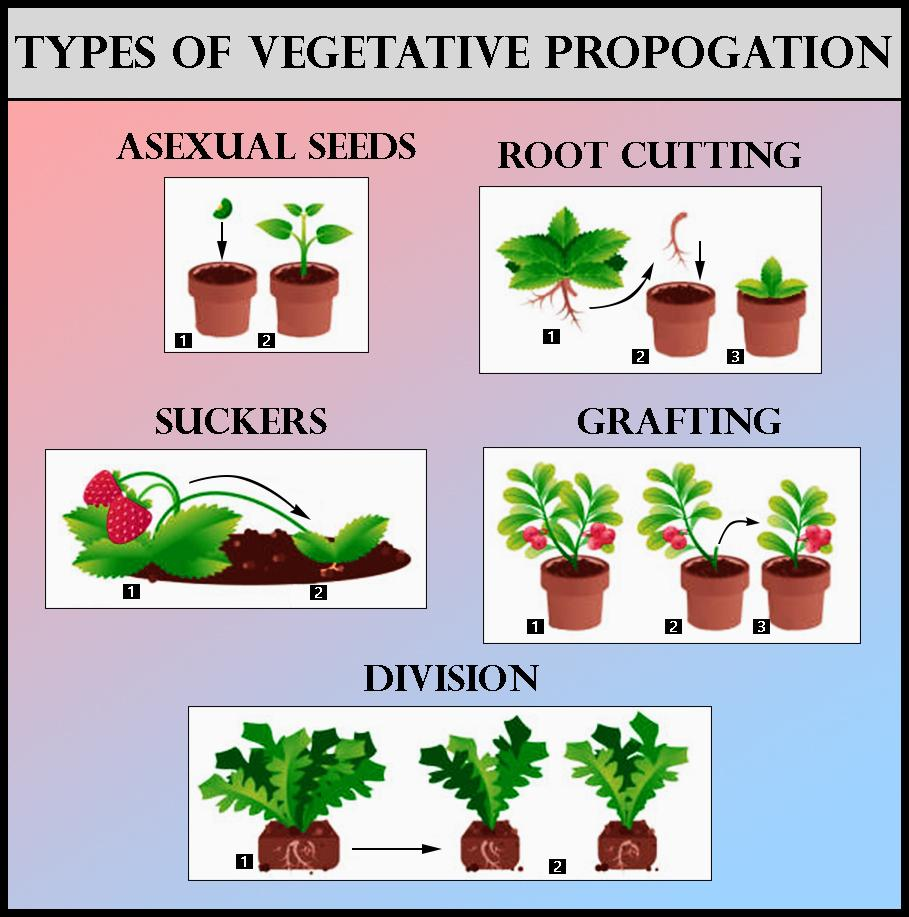Why Is Vegetative Propagation Important in Plant Biology?
Vegetative propagation is an efficient method of reproducing plants without using seeds. In this comprehensive guide, we will explain what is vegetative propagation, define vegetative propagation clearly, and explore its various types of vegetative propagation. We will also discuss the advantages of vegetative propagation and provide plenty of vegetative propagation examples. Additionally, we address why is vegetative propagation practised for growing some types of plants and share extra tips that go beyond traditional textbooks.
Vegetative Propagation - Overview
Vegetative propagation is an asexual reproduction method where new plants develop from parts of an existing plant. Vegetative propagation is the process by which plant organs such as stems, leaves, and roots produce genetically identical offspring. This method allows gardeners and horticulturists to rapidly multiply plants with desirable traits, making it a key technique in agriculture and gardening.
Many might wonder, why is vegetative propagation practised for growing some types of plants. The answer is straightforward: it allows the transfer of exact genetic material from the parent, ensuring uniformity and preservation of favourable characteristics. This is especially useful in commercial cultivation where consistency is paramount.
Also Check: Parts of a Plant

Read More: Asexual Reproduction in Plants
Types of Vegetative Propagation
Several types of vegetative propagation occur both naturally and through human intervention. Each method offers unique advantages and suits different plant species and growing conditions.
Natural Vegetative Propagation
Natural vegetative propagation happens without human aid and relies on the plant’s innate ability to reproduce. Here are some key methods:
Rhizomes and Runners: Many plants, such as strawberries and certain grasses, produce horizontal stems (runners) or underground stems (rhizomes). Buds form at the nodes, and these buds develop into new plants. These are classic vegetative propagation examples.
Tubers: Plants like potatoes develop modified, swollen roots called tubers. Buds at the ‘eyes’ of the tubers sprout to form new plants. This process is a clear case of what is vegetative propagation in action.
Bulbs: Bulbs consist of a short stem surrounded by fleshy, food-storing leaves. Each bulb typically contains an apical bud that can grow into a new plant. Bulb formation is another prime vegetative propagation example.
Leaf Propagation: Some species are capable of growing new plants from a single leaf. When a leaf falls off and finds a suitable environment, it can produce adventitious roots, forming a complete plant.
Artificial Vegetative Propagation
Humans have also harnessed these natural processes to develop more controlled and efficient methods. Common artificial types of vegetative propagation include:
Cutting: In this method, a part of the plant (usually a stem or leaf) is cut and planted in the soil. Treated with rooting hormones, the cutting produces adventitious roots, giving rise to a new plant. This is one of the simplest ways to practise vegetative propagation.
Grafting: Grafting involves joining a piece of one plant (the scion) to the stem or root system of another (the rootstock). Over time, the tissues merge and grow together, ensuring the new plant carries the desired traits from both parents.
Layering: Layering is an ingenious method where a part of the stem is bent to the ground and covered with soil. As roots develop from the covered section, a new plant forms. This method is particularly useful for plants that are sensitive to cutting.
Tissue Culture: Also known as micropropagation, tissue culture involves growing plant cells in a controlled laboratory environment. Small pieces of plant tissue are cultured in a nutrient-rich medium to produce multiple plants. This modern technique allows rapid propagation and conservation of rare species.

Advantages of Vegetative Propagation
Understanding the advantages of vegetative propagation helps us appreciate why this technique is widely used in agriculture and horticulture. Some of the benefits include:
Genetic Uniformity: Since the new plants are clones of the parent, they maintain consistent traits such as fruit quality, colour, and resistance to pests. This is particularly important for commercial growers.
Rapid Multiplication: Vegetative propagation is usually faster than seed propagation. Farmers and gardeners can produce large numbers of plants in a short period.
Reliable Reproduction: Some plants do not produce viable seeds or take a long time to germinate. In such cases, vegetative propagation is the ideal method for mass production.
Preservation of Special Traits:When we define vegetative propagation, one of its significant advantages is the ability to maintain the genetic traits of a plant that is particularly disease-resistant or high-yielding.
Efficient for Clonal Varieties: Many popular ornamental plants and crops benefit from this method, as it ensures uniform growth and reliable performance in varying environments.
By summarising these advantages of vegetative propagation, it becomes clear why many horticulturists prefer this method over traditional seed propagation.
Additional Insights and Unique Applications
Beyond the standard methods, here are some unique aspects that further illustrate what is vegetative propagation and its practical relevance:
Environmental Adaptability: Vegetative propagation allows plants to adapt to local environmental conditions rapidly. For instance, certain species can form dense mats via runners or rhizomes, helping stabilise soil and prevent erosion.
Disease Management: While clones can sometimes be more susceptible to disease, modern techniques like tissue culture enable the production of disease-free plants. Advanced sterilisation methods in tissue culture ensure that new plants are free from pathogens.
Conservation Efforts: Vegetative propagation is a critical tool in conservation biology. It helps propagate endangered species that may have difficulty producing viable seeds, thereby preserving biodiversity.
Economic Benefits: For commercial growers, the rapid and uniform production of plants via vegetative propagation often translates into higher yields and better market consistency.
By addressing why is vegetative propagation practised for growing some types of plants, we see that it is not only a method of reproduction but also a strategic tool for sustainability, economic gain, and environmental management.
Disadvantages of Vegetative Propagation
No method is without its challenges. The main disadvantages of vegetative propagation include:
Limited Genetic Variation: Since all plants are genetically identical, they may be collectively vulnerable to pests, diseases, or changing climate conditions.
Size and Longevity: Vegetatively propagated plants can sometimes be smaller or have a shorter lifespan compared to those grown from seeds.
Skill and Cost: Techniques like grafting or tissue culture require specialised skills and can be more expensive compared to traditional seed propagation.
Potential Disease Spread: If a parent plant carries a disease, the entire clonal population can be affected, which emphasises the need for careful selection and management.


FAQs on Vegetative Propagation Explained: Types, Examples, and Benefits
1. What exactly is vegetative propagation in plants?
Vegetative propagation is a type of asexual reproduction where a new plant grows from a vegetative part of the parent plant, such as its root, stem, or leaf, rather than from a seed. The new plant is a genetically identical clone of the parent, carrying all its characteristics.
2. What are the main types of vegetative propagation?
There are two primary categories of vegetative propagation:
- Natural Vegetative Propagation: This occurs without human intervention. Common methods include the development of new plants from rhizomes (ginger), runners (strawberry), tubers (potato), and bulbs (onion).
- Artificial Vegetative Propagation: This involves human techniques to clone plants. Key methods include cutting, grafting, layering, and tissue culture (micropropagation).
3. What are some common examples of natural vegetative propagation?
Several plants reproduce naturally using this method. Common examples include:
- Potatoes: New plants sprout from the 'eyes' on the tuber.
- Strawberries: Horizontal stems called runners grow along the ground and develop new plants at their nodes.
- Ginger: The underground stem, or rhizome, sprouts new shoots to form new plants.
- Bryophyllum: New plantlets with adventitious roots develop along the notches of its leaves.
4. What are the key methods of artificial vegetative propagation used in horticulture?
Horticulturists use several artificial methods to propagate plants with desired traits:
- Cutting: A piece of stem or leaf is cut from a parent plant and planted, where it develops roots and grows into a new plant. Example: Rose, Bougainvillea.
- Grafting: A stem piece (scion) of a desired plant is attached to the root system (stock) of another plant. Example: Mango, Apple.
- Layering: A stem attached to the parent plant is bent to the ground and covered with soil, inducing it to grow roots. Example: Jasmine.
- Tissue Culture (Micropropagation): Plant cells or tissues are grown in a sterile nutrient medium in a lab to produce thousands of plantlets. Example: Orchids.
5. Why do farmers and gardeners often prefer vegetative propagation over growing plants from seeds?
Vegetative propagation is preferred for several practical reasons. Plants grown this way mature and bear fruit much faster than those grown from seed. It also ensures genetic uniformity, meaning all offspring will have the same desirable qualities as the parent, such as fruit taste, flower colour, or disease resistance. Furthermore, this method is essential for propagating plants that produce non-viable seeds or are seedless, like bananas and some grape varieties.
6. How does grafting differ from cutting as a method of artificial propagation?
The main difference lies in the number of plants involved. In cutting, a part of a single parent plant is used to grow a new, complete plant on its own roots. In grafting, parts from two different plants are combined: the scion (a shoot from the plant with desired fruit or flowers) and the rootstock (the root system of a hardy, well-adapted plant). This allows growers to combine the best traits of two plants into one.
7. What is the main drawback of relying solely on vegetative propagation for a large population of crops?
The most significant disadvantage is the lack of genetic variation. Since all plants are clones of a single parent, they are all equally susceptible to the same diseases, pests, or adverse environmental changes. A single new disease or pest could potentially wipe out the entire crop population, whereas genetically diverse populations grown from seeds would likely have some individuals with natural resistance.
8. How is tissue culture a significant advancement in vegetative propagation?
Tissue culture, or micropropagation, is a major advancement because it allows for the extremely rapid production of thousands of plants from a tiny piece of parent tissue in a sterile, controlled lab environment. This technique is crucial for producing disease-free plants, as the process can eliminate viruses and other pathogens. It is also a vital tool for the conservation of rare and endangered species that are difficult to grow by other means.










